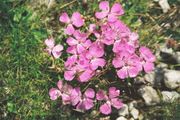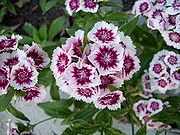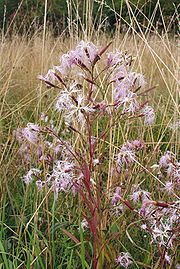
Dianthus
Encyclopedia



Genus
In biology, a genus is a low-level taxonomic rank used in the biological classification of living and fossil organisms, which is an example of definition by genus and differentia...
of about 300 species
Species
In biology, a species is one of the basic units of biological classification and a taxonomic rank. A species is often defined as a group of organisms capable of interbreeding and producing fertile offspring. While in many cases this definition is adequate, more precise or differing measures are...
of flowering plant
Flowering plant
The flowering plants , also known as Angiospermae or Magnoliophyta, are the most diverse group of land plants. Angiosperms are seed-producing plants like the gymnosperms and can be distinguished from the gymnosperms by a series of synapomorphies...
s in the family Caryophyllaceae
Caryophyllaceae
The Caryophyllaceae, commonly called the pink family or carnation family, is a family of flowering plants. It is included in the dicotyledon order Caryophyllales in the APG III system, alongside 33 other families, including Amaranthaceae, Cactaceae and Polygonaceae...
, native mainly to Europe
Europe
Europe is, by convention, one of the world's seven continents. Comprising the westernmost peninsula of Eurasia, Europe is generally 'divided' from Asia to its east by the watershed divides of the Ural and Caucasus Mountains, the Ural River, the Caspian and Black Seas, and the waterways connecting...
and Asia
Asia
Asia is the world's largest and most populous continent, located primarily in the eastern and northern hemispheres. It covers 8.7% of the Earth's total surface area and with approximately 3.879 billion people, it hosts 60% of the world's current human population...
, with a few species extending south to north Africa
Africa
Africa is the world's second largest and second most populous continent, after Asia. At about 30.2 million km² including adjacent islands, it covers 6% of the Earth's total surface area and 20.4% of the total land area...
, and one species (D. repens) in arctic North America
North America
North America is a continent wholly within the Northern Hemisphere and almost wholly within the Western Hemisphere. It is also considered a northern subcontinent of the Americas...
. Common names include carnation (D. caryophyllus), pink (D. plumarius and related species) and sweet William (D. barbatus). The name Dianthus is from the Greek
Greek language
Greek is an independent branch of the Indo-European family of languages. Native to the southern Balkans, it has the longest documented history of any Indo-European language, spanning 34 centuries of written records. Its writing system has been the Greek alphabet for the majority of its history;...
words dios ("god") and anthos ("flower"), and was cited by the Greek botanist Theophrastus
Theophrastus
Theophrastus , a Greek native of Eresos in Lesbos, was the successor to Aristotle in the Peripatetic school. He came to Athens at a young age, and initially studied in Plato's school. After Plato's death he attached himself to Aristotle. Aristotle bequeathed to Theophrastus his writings, and...
.
The species are mostly perennial herbs, a few are annual or biennial, and some are low subshrub
Subshrub
A subshrub or dwarf shrub is a short woody plant. Prostrate shrub is a similar term.It is distinguished from a shrub by its ground-hugging stems and lower height, with overwintering perennial woody growth typically less than 10–20 cm tall, or by being only weakly woody and/or persisting...
s with woody basal stems. The leaves
Leaf
A leaf is an organ of a vascular plant, as defined in botanical terms, and in particular in plant morphology. Foliage is a mass noun that refers to leaves as a feature of plants....
are opposite, simple, mostly linear and often strongly glaucous grey-green to blue-green. The flower
Flower
A flower, sometimes known as a bloom or blossom, is the reproductive structure found in flowering plants . The biological function of a flower is to effect reproduction, usually by providing a mechanism for the union of sperm with eggs...
s have five petals, typically with a frilled or pinked margin, and are (in almost all species) pale to dark pink. One species, D. knappii, has yellow flowers with a purple centre.
Dianthus species are used as food plants by the larva
Larva
A larva is a distinct juvenile form many animals undergo before metamorphosis into adults. Animals with indirect development such as insects, amphibians, or cnidarians typically have a larval phase of their life cycle...
e of some Lepidoptera
Lepidoptera
Lepidoptera is a large order of insects that includes moths and butterflies . It is one of the most widespread and widely recognizable insect orders in the world, encompassing moths and the three superfamilies of butterflies, skipper butterflies, and moth-butterflies...
species including Cabbage Moth
Cabbage Moth
Note: the Small White species of butterfly is commonly called a "cabbage moth" in North America.The Cabbage Moth is a common European moth of the family Noctuidae....
, Double-striped Pug
Double-striped Pug
The Double-striped Pug is a moth of the family Geometridae. It is a widespread and common species, being found throughout the Palearctic region, the Near East and North Africa....
, Large Yellow Underwing
Large Yellow Underwing
The Large Yellow Underwing is a moth, the type species for the family Noctuidae. It is an abundant species throughout Europe, one of the most common and most familiar moths of the region. In some years the species is highly migratory with large numbers appearing suddenly in marginal parts of the...
and The Lychnis
Lychnis (moth)
The Lychnis is a moth of the family Noctuidae. It is found in northern and western Europe.This species has dark brown forewings marked with two prominent white-bordered stigmata and a white subterminal line. The hindwings are buffish, darkening to brown towards the margin but with a prominent...
. Also three species of Coleophora
Coleophora
Coleophora is a very large genus of moths of the family Coleophoridae. It contains some 1,350 described species. The genus is represented on all continents, but the majority are found in the Nearctic and Palaearctic regions...
case-bearers feed exclusively on Dianthus; C. dianthi, C. dianthivora and C. musculella (which feeds exclusively on D. suberbus).
The color pink
Pink
Pink is a mixture of red and white. Commonly used for Valentine's Day and Easter, pink is sometimes referred to as "the color of love." The use of the word for the color known today as pink was first recorded in the late 17th century....
may be named after the flower, coming from the frilled edge of the flowers: the verb "pink" dates from the 14th century and means "to decorate with a perforated or punched pattern" (maybe from German "picken" = to peck). Source: Collins Dictionary. This verb sense is also used in the name of pinking shears
Pinking shears
Pinking shears are scissors, the blades of which are sawtoothed instead of straight. They leave a zigzag pattern instead of a straight edge.Pinking shears have a utilitarian function for cutting woven cloth. Cloth edges that are unfinished will easily fray, the weave becoming undone and threads...
.
Culture
Dianthus gratianopolitanus - the Cheddar Pink - was chosen as the County flowerCounty flowers of the United Kingdom
The following are the flowers selected for the historic counties of the United Kingdom in Plantlife's 2002 "County Flowers" campaign...
of Somerset
Somerset
The ceremonial and non-metropolitan county of Somerset in South West England borders Bristol and Gloucestershire to the north, Wiltshire to the east, Dorset to the south-east, and Devon to the south-west. It is partly bounded to the north and west by the Bristol Channel and the estuary of the...
in 2002 following a poll by the wild flora conservation charity Plantlife
Plantlife
Plantlife is a wild plant conservation charity. As of 2007, its membership was 10,500 and it owned 23 nature reserves around the UK.-History:It was founded in 1989 with its first President being Professor David Bellamy. By 1999 it had 22 nature reserves....
.
Selected species
|
Dianthus japonicus Dianthus japonicus is a species of herbaceous perennial plant in the genus Dianthus.... Dianthus monspessulanus Dianthus monspessulanus, common name the Fringed Pink, is a herbaceous perennial plant of the genus Dianthus belonging to the Caryophyllaceae family... - Fringed pink Dianthus nardiformis Dianthus nardiformis or Dianthus gelidus is a species of herbaceous perennial plant in the genus Dianthus.... Dianthus pavonius Dianthus pavonius, common name Peacock-eye Pink, is a herbaceous perennial plant of the genus Dianthus belonging to the Caryophyllaceae family.-Etymology:... Dianthus seguieri Dianthus seguieri, common name Sequier's Pink, is a herbaceous perennial plant of the genus Dianthus belonging to the Caryophyllaceae family.-Etymology:... - Sequier's Pink Dianthus superbus Dianthus superbus is a species of Dianthus native to Europe and northern Asia, from northernmost Spain and France north to arctic Norway, and east to Japan; in the south of its range, it occurs at high altitudes, up to 2,400 m.... - Large Pink |
Cultivation
There are also many hybrids, eg. D. x allwoodii (D. plumarius × D. caryophyllus), which may be further crossed, eg D. x allwoodii 'Alpinus' (D. x allwoodii with D. alpinus).Common hybrids include:
- Dianthus x hybrida 'Rainbow Loveliness' - Sweet Pink

